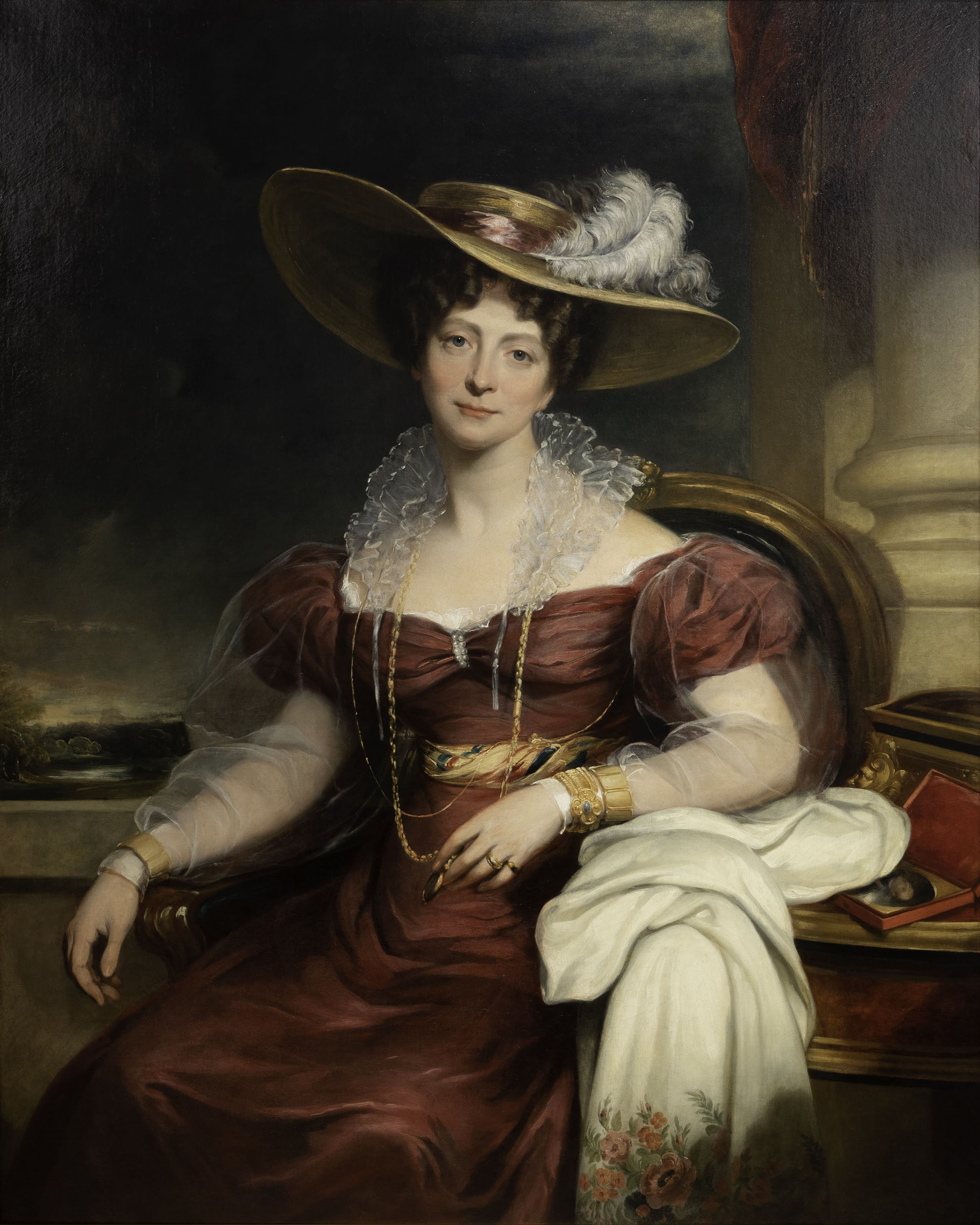Sir Martin Archer Shee P.R.A.
b. 1769, Dublin
d. 1850, Brighton
Elizabeth, Duchess of Rutland
1820
Oil on canvas
127 x 101.7 cm (50 x 40 1/8 in.)
Provenance
T.J. Blakeslee, 1905;
Joseph and Kate Davis Pulitzer;
Private Collection London, 1986 to the present day.
Joseph and Kate Davis Pulitzer;
Private Collection London, 1986 to the present day.
Literature
W.G. Strickland, Dictionary of Irish Artists, Dublin, 1913, p. 344.
The British Face, P & D Colnaghi exhibition catalogue, ill. n. 58, p. 118.
The British Face, P & D Colnaghi exhibition catalogue, ill. n. 58, p. 118.
Description
Archer Shee studied in his native city of Dublin under F.R. West, winning all the premiums. He initially concentrated on working in crayon, but soon turned to oil. Arriving in London in 1788, he entered the Royal Academy Schools to finish his training. He was elected a member of the Royal Academy in 1800, and on Lawrence's death in 1830 became President and was knighted. His style owed much to Lawrence, and he too catered for the fashionable market, being particularly skilled with women and children.
The sitter of this three-quarter length portrait is seated in an armchair, as if on an architectural balcony overlooking a landscaped park. She wears a red dress with puffed sleeves and tulle ruff, her fashionable hair style partly concealed by a wide-brimmed hat with a pink ribbon and white ostrich feather. On the table beside her is an embroidered shawl, a miniature of her husband, John Henry, 5th Duke of Rutland, and her elaborate work box.
Elizabeth, Duchess of Rutland (d. 1825), was one of the most remarkable women of her time. Born a Howard of Castle Howard, daughter of Frederick, 5th Earl of Carlisle, on her marriage she found her new home at Belvoir, not at all her idea of how a ducal castle should look. Aided by the architect James Wyatt, his three sons—Matthew Cotes, Benjamin Dean and Philip—and her husband's chaplain, the Revd Sir John Thoroton, she promptly set about transforming her husband's seat into a sumptuous early nineteenth-century evocation of the Middle Ages crossed with Versailles.
She herself was an enthusiastic architectural amateur, and her architectural drawings were considered worthy of a professional. She painted in the manner of Claude, and landscaped the park at Belvoir, as well as designing and managing the home farm there. Of the Duchess, Mrs Arbuthnot wrote in her Journal: "She was the builder of the castle and Belvoir is indebted to her for all its beauty and decorations. She certainly was a woman of genius and talent mixed up with a great deal of vanity and folly" (Journal of Mrs Arbultnot, ed. The Duke of Wellmgton & J. Bamford, 1950, p. 230).
This glossy, yet sympathetic, portrait captures the 'vanity and folly', as well as some of the serious side of the Duchess. It is one of Archer Shee's best portraits, showings his special ability in rendering female sitters. It compares well with the two more mouvementé full-length representations of the Duchess at Belvoir by Sir George Hayter and John Hoppner respectively, one showing her with her sketchbook and the other leaning on a column in her favorite flower garden. Such details as the handling of the transparent tulle of the ruff and sleeves in this portrait are a dazzling display of virtuoso realism, almost trompe l'oeil in their naturalism.
The sitter of this three-quarter length portrait is seated in an armchair, as if on an architectural balcony overlooking a landscaped park. She wears a red dress with puffed sleeves and tulle ruff, her fashionable hair style partly concealed by a wide-brimmed hat with a pink ribbon and white ostrich feather. On the table beside her is an embroidered shawl, a miniature of her husband, John Henry, 5th Duke of Rutland, and her elaborate work box.
Elizabeth, Duchess of Rutland (d. 1825), was one of the most remarkable women of her time. Born a Howard of Castle Howard, daughter of Frederick, 5th Earl of Carlisle, on her marriage she found her new home at Belvoir, not at all her idea of how a ducal castle should look. Aided by the architect James Wyatt, his three sons—Matthew Cotes, Benjamin Dean and Philip—and her husband's chaplain, the Revd Sir John Thoroton, she promptly set about transforming her husband's seat into a sumptuous early nineteenth-century evocation of the Middle Ages crossed with Versailles.
She herself was an enthusiastic architectural amateur, and her architectural drawings were considered worthy of a professional. She painted in the manner of Claude, and landscaped the park at Belvoir, as well as designing and managing the home farm there. Of the Duchess, Mrs Arbuthnot wrote in her Journal: "She was the builder of the castle and Belvoir is indebted to her for all its beauty and decorations. She certainly was a woman of genius and talent mixed up with a great deal of vanity and folly" (Journal of Mrs Arbultnot, ed. The Duke of Wellmgton & J. Bamford, 1950, p. 230).
This glossy, yet sympathetic, portrait captures the 'vanity and folly', as well as some of the serious side of the Duchess. It is one of Archer Shee's best portraits, showings his special ability in rendering female sitters. It compares well with the two more mouvementé full-length representations of the Duchess at Belvoir by Sir George Hayter and John Hoppner respectively, one showing her with her sketchbook and the other leaning on a column in her favorite flower garden. Such details as the handling of the transparent tulle of the ruff and sleeves in this portrait are a dazzling display of virtuoso realism, almost trompe l'oeil in their naturalism.




